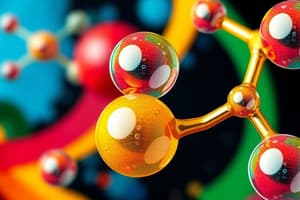Podcast
Questions and Answers
What is the maximum number of bonds that carbon atoms can form?
What is the maximum number of bonds that carbon atoms can form?
- 4 (correct)
- 2
- 3
- 5
Which type of carbon chain is characterized by having no branches?
Which type of carbon chain is characterized by having no branches?
- Acyclic (correct)
- Branched
- Benzene
- Cyclic
What distinguishes alkenes from alkanes?
What distinguishes alkenes from alkanes?
- Alkenes undergo polymerization at normal conditions.
- Alkenes contain double bonds. (correct)
- Alkenes are fully saturated.
- Alkenes only form single bonds.
Which of the following best describes isomers?
Which of the following best describes isomers?
Which reaction type applies to arenes during intense conditions?
Which reaction type applies to arenes during intense conditions?
Which statement accurately describes tertiary carbon atoms?
Which statement accurately describes tertiary carbon atoms?
What is a characteristic feature of polyols?
What is a characteristic feature of polyols?
What is the primary production method for ethyne?
What is the primary production method for ethyne?
What distinguishes primary carbon atoms from secondary and tertiary carbon atoms?
What distinguishes primary carbon atoms from secondary and tertiary carbon atoms?
Flashcards are hidden until you start studying
Study Notes
Organic Chemistry: Composition
- All organic compounds contain carbon
- Other common elements include hydrogen, oxygen, nitrogen, sulfur, and phosphorus
Carbon Atom Features
- Carbon atoms are excited, forming four bonds
- Carbon atoms bond to form chains
- Carbon atoms form covalent bonds with different multiplicities: single, double, and triple
Types of Carbon Atoms
- Primary (1°): Connected to one other carbon atom
- Secondary (2°): Connected to two other carbon atoms
- Tertiary (3°): Connected to three other carbon atoms
- Quaternary (4°): Connected to four other carbon atoms
Types of Carbon Chains
- Open (acyclic)
- Straight: No branches
- Branched: Contains branches
- Cyclic:
- No branches: Simple ring structure
- Branched: Contains branches within a ring structure
Isomers
- Molecules with the same qualitative and quantitative compositions
- Share the same molecular formula and molar mass but have different properties
Alkanes
- Saturated hydrocarbons with single bonds
- Form a homologous series (differing by CH2 units)
- Exhibit isomerism
- Chemical properties:
- Combustion: React with oxygen to produce carbon dioxide and water
- Halogenation: React with halogens (e.g., chlorine) to form haloalkanes
Alkenes
- Unsaturated hydrocarbons with at least one double bond
- Form a homologous series
- Exhibit isomerism
- Chemical properties:
- Combustion: React with oxygen to produce carbon dioxide and water
- Addition reactions: Add molecules across the double bond (e.g., hydrogen, water, halogens)
- Polymerization: Form long chains by joining multiple alkene molecules
- Production: Dehydration of ethane or ethanol
Alkynes
- Unsaturated hydrocarbons with at least one triple bond
- Form a homologous series
- Exhibit isomerism
- Chemical properties:
- Combustion: React with oxygen to produce carbon dioxide and water
- Addition reactions: Add molecules across the triple bond (e.g., hydrogen, halogens)
- Trimerization: Three alkyne molecules combine to form a cyclic compound
Arenes
- Cyclic hydrocarbons with delocalized electron systems
- Benzene: The parent compound with a six-membered ring and alternating single and double bonds
- Alkylbenzenes: Benzene derivatives with alkyl groups attached
- Chemical properties:
- Substitution reactions: Replace hydrogen atoms on the ring with other groups
- Addition reactions: Add molecules across the ring but require harsh conditions
Alcohols (Alkanols)
- Contain the hydroxyl group (-OH)
- Form hydrogen bonds due to the polar hydroxyl group
- Chemical properties:
- Acidic properties: React with active metals to release hydrogen gas
- Esterification: React with acids to form esters
- Combustion: React with oxygen to produce carbon dioxide and water
- Dehydration: Eliminate a water molecule to form an alkene
Polyols
- Contain multiple hydroxyl groups
- Examples include ethylene glycol and glycerol
- Chemical properties:
- React with sodium
- React with nitric acid
- React with freshly precipitated copper(II) hydroxide
- Combustion: React with oxygen
Production and Applications
- Details on the production and applications of specific compounds are provided in the text.
Studying That Suits You
Use AI to generate personalized quizzes and flashcards to suit your learning preferences.




